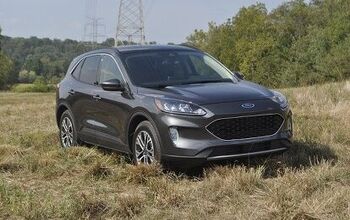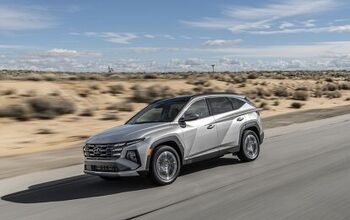2020 Ford Escape Hybrid First Drive - To Plug or Not to Plug

The 2020 Ford Escape Hybrid faces the same problem as its gas-engined sibling: Styling.
That’s the bad news for Ford. The good news is that this particular hybrid doesn’t sacrifice too much of the gas Escape’s fun-to-drive factor in the search for better fuel economy.
(Full disclosure: Ford flew me to Louisville, Kentucky and fed and housed me so that I could drive the new Escape. The company also offered a bourbon tasting and allowed journalists to participate in a fake horse-race betting game. I did not partake in the latter, as I have already lost enough real money on horse racing).
As I wrote earlier this week, the new 2020 Escape, while styled controversially, is among the more engaging compact crossovers when it comes to how it drives. That mostly carries over to the hybrid model.
Not only is Ford offering a “regular” hybrid (SE Sport and Titanium trim), there’s also a plug-in model on hand for SE, SEL, and Titanium trims.
The hybrid system involves a 2.5-liter four-cylinder engine and an electronic continuously variable automatic transmission. With front-wheel drive, the “regular” hybrid has an estimated combined 200 system horsepower and 152 lb-ft of torque (when using gas), and Ford is claiming an electric-only top speed of 85 mph. Ford also says the plug-in will boast up to 30 miles of electric-only range before needing to switch back to burning dead dinos. In front-wheel drive form, the standard hybrid will offer a range of over 550 miles.
[Get new and used Ford Escape prices here!]
In a bid to avoid eating into the vehicle’s rear cargo volume (a la Fusion Energi), Ford shifted the system’s lithium-ion battery beneath the floor.
Different drive modes allow the driver to let the car decide whether to run on electric or gas, or to dispense with gas altogether. The driver can also choose to power the Escape with gas only, saving electric power for later. Finally, a plug-in specific mode allows the driver to charge the battery while driving, generating electric power that can be used at a later time.
I didn’t see 85 mph in electric mode in the SE Sport with front-wheel drive I drove, in part because I was driving in traffic on suburban roads, and in part because I had the vehicle in Sport mode. Do that, and the Escape won’t do EV-only.
That’s fine – like with the gas version, Sport mode made the already sprightly Escape a bit livelier. From a ride and handling perspective, I prefer this little ‘ute to one of its main rivals, the Toyota RAV4 hybrid.
For the most part, the Escape hybrid doesn’t drive drastically different from the gas-engined model. It’s a little slower to accelerate, but you can still pass and merge easily enough.
The SE Sport hybrid starts at $28,255, and the one I drove came equipped with 19-inch wheels, panoramic sunroof, power liftgate, remote start, adaptive cruise control with stop and go, navigation, and satellite radio. Ford’s Co-Pilot 360 suite of driver-aid and safety tech is standard.
Final price? $32,345, including the $1,195 destination fee. The EPA hasn’t worked its fuel-economy magic on the hybrid yet.
Personally, I think I’d buy the 2.0-liter gas-engined Escape, since it was the most fun to wheel. But were I need of a hybrid and I was shopping in this class, I’d give the Escape a long look. It’s just more engaging to drive than the its Toyota rival.
The problem is “look.” I’m a bit put off by the anonymous styling; meanwhile, the RAV4 has newfound rugged looks that make it a head-turner for the first time in a while, if ever.
If you’re not bothered by the styling, or if the look appeals to you, then Ford has a hybrid that’s fun to drive on offer.
You can even order it with a plug.
Anonymity aside, there’s always room in the world for hybrid crossovers that don’t stink to drive. Toyota, take note.
[Images © 2019 Tim Healey/TTAC]

Tim Healey grew up around the auto-parts business and has always had a love for cars — his parents joke his first word was “‘Vette”. Despite this, he wanted to pursue a career in sports writing but he ended up falling semi-accidentally into the automotive-journalism industry, first at Consumer Guide Automotive and later at Web2Carz.com. He also worked as an industry analyst at Mintel Group and freelanced for About.com, CarFax, Vehix.com, High Gear Media, Torque News, FutureCar.com, Cars.com, among others, and of course Vertical Scope sites such as AutoGuide.com, Off-Road.com, and HybridCars.com. He’s an urbanite and as such, doesn’t need a daily driver, but if he had one, it would be compact, sporty, and have a manual transmission.
More by Tim Healey
Latest Car Reviews
Read moreLatest Product Reviews
Read moreRecent Comments
- SCE to AUX They're spending billions on this venture, so I hope so.Investing during a lull in the EV market seems like a smart move - "buy low, sell high" and all that.Key for Honda will be achieving high efficiency in its EVs, something not everybody can do.
- ChristianWimmer It might be overpriced for most, but probably not for the affluent city-dwellers who these are targeted at - we have tons of them in Munich where I live so I “get it”. I just think these look so terribly cheap and weird from a design POV.
- NotMyCircusNotMyMonkeys so many people here fellating musks fat sack, or hodling the baggies for TSLA. which are you?
- Kwik_Shift_Pro4X Canadians are able to win?
- Doc423 More over-priced, unreliable garbage from Mini Cooper/BMW.





































Comments
Join the conversation
The design seems very clean compared to most of today's designs. I actually think it looks very nice compared to most in the segment.
Please, TTAC, spare me your continuing critique of the styling. First of all, I drive a truly ugly C-Max, so I can accept most anything that works well. Secondly, don't tell me how I'm supposed to feel about something few of has seen in the flesh. I'll make up my own mind about styling, thanks, and others will disagree still. I have two objective questions for you expert reviewers about this vehicle. 1) Did they add water cooling to the battery pack, for better longevity? 2) Does it have my C-Max's "DISP" button to turn off the central dash screen when it's not needed? (For me, that's 90% of the time.)